|
FAQs on Characoids/Tetras & Relatives Disease/Health
5
FAQs on Characoid Disease:
Characoid Disease 1,
Characoid Disease 2,
Characoid Disease 3,
Tetra Disease 4, Tetra Disease 6,
FAQs on Characoid Disease by Category:
Diagnosis,
Environmental,
Nutritional,
Infectious,
Parasitic,
Social,
Treatments
Related Articles:
Characoids/Tetras & Relatives,
Related FAQs: Characoids/Tetras &
Relatives, Characoid
Identification, Characoid
Behavior, Characoid
Compatibility, Characoid
Selection, Characoid Systems,
Characoid Feeding,
Characoid Reproduction,
|
|
|
New Nematobrycon palmeri in quarantine...
Hello WWM Crew!
<Hello Rene!>
I am coming to you with a question and hopefully a possible diagnosis for what
is going on with these guys. I recently received 6 Nematobrycon from a fish farm
that is usually reputable so I will keep their name to myself for now.
<Understood. Emperor Tetras are usually good value. They're adaptable and not
prone to disease.>
I Ordered these guys a few weeks ago but they were just sent this week. I got
them unpacked and into the quarantine tank when I noticed that 4 of the six had
strange looking (bumps/growth?) on their chin area sizes of the growths vary
from fish to fish. Not sure if it is some kind of birth defect, tumor or
parasite possibly?
<The fact all of them have the odd mouth defect is striking. I have seen the
occasional tetra with this sort of thing, usually in Neons, and put it down to a
birth defect or possibly the result of fighting. Whether such a defect is
genetic or caused by, for example, lack of some key nutrient during growth is
hard to say.>
It doesn't look like fungus to me, not cotton like or hairy. More like a
growth/tumor of some kind.
<Agreed.>
I did message the farm about it within minutes of getting them sorted in the
tank for inspection. That was yesterday morning and I have not heard back from
them as of yet (possibly due to the weekend) so I have been looking online for
any kind of answers. I have come up with nothing. I can send my tank info if
needed I just didn't think it was relevant considering this particular
situation. I am including the best pics I could manage to get as they are quick
little things. Some of them are eating but not all of them.
<If they're feeding, then a non-lethal birth defect may be the case here.
But I would still expect a full refund, even if sending the fish back is
pointless. No reason to destroy them humanely if they can feed, but neither
should you accept them as good or even acceptable quality Emperor Tetras that
satisfy your contract with the seller.>
I do not want to just start dumping meds into the water unless needed.
<Agreed; and without symptoms, any medication would be random.>
I do have Kanaplex, API General Cure, Jungle Fungus Clear and Levamisole HCI on
hand if any of those would be helpful. Any thoughts would be greatly
appreciated! Thank you in advance. Rene'
<Most welcome. Cheers, Neale.>
Filter is only a couple weeks old.
<I don't understand this exactly. Do you mean you changed the old filter for a
new one? If so, then the new filter could be cycling and ammonia and nitrite
above zero. That could easily account for the problem. If you mean the tank had
no filter at all until two weeks ago, I'm surprised this puffer survived until
now.>
I know not to change everything all at once. Is he dying? I think I'll die if he
does.
<My first step would be to check the salinity. Strongly brackish water will
help. If you're dosing salt in "teaspoon per gallon" amounts then you're not
doing it right. You really need substantial amounts of marine salt mix. For SG
1.005, at 25 C you'd be dosing the salt at 9 grams per litre (1.2 oz per US
gallon) which is quite a bit -- 9 grams is about 1.5 teaspoons of typical salt
mix. I'm also going to ask you to check the ammonia and/or nitrite levels. If
they're not zero, then that's a major problem that needs urgent attention. I'm
finally going to have you do some reading, here:
http://www.wetwebmedia.com/brackishsubwebindex/gspsart.htm
Hope this helps, Neale.>
|
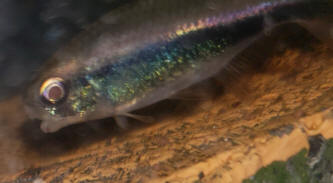 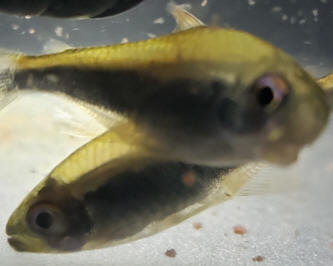 |
|
Re: New Nematobrycon palmeri in quarantine...
4/1/19
Hello Neale!
<Good afternoon!>
Thank you for responding so promptly!
<Welcome.>
I honestly hadn't even thought about asking for a refund as they arrived
alive. I will definitely look into that as its always a bit more costly
ordering fish directly.
<Indeed it is, hence the usual contract in terms of safe arrival of
livestock.>
Unfortunately we have no quality pet stores in my area, just a Petco and
you couldn't pay me to take home anything they have. That said, a birth
defect or possible injury from fighting is actually a relief to hear
considering the other possibilities.
<Understood.>
I wanted to find out as much as possible as soon as possible as some
things are so time sensitive when it comes to most fish illnesses.
<Correct.>
Aside from this they appear to be healthy.
<Good; and if feeding and behaving normally, this is a good reason to
assume a birth defect.>
Thank you again for your time and response. We really do rely so much on
this site and all of you when it comes to our aquatic hobby. Sorry about
the lengthy messages. Thank you again!
<And thank you for these kind words. Cheers, Neale.>
|
Now: AZGardens, not sending the right fish/replying to messages (Was:
New Nematobrycon Palmeri in quarantine...) 4/3/19
Re: New Nematobrycon Palmeri in quarantine...
Sorry to add on, but something else I notice is bothering me... I don't think I
was even sent the correct species.
<Does indeed seem the case with these photos.>
Once they settled in and I was able to get a better look at them. I would like a
second opinion. I am attaching a couple of new pics with them colored up, as
well as a stock photo of what I believe them to be.
<Indeed.>
The first thing I noticed was that they have adipose fins. If I remember
correctly Nematobrycon Palmeri (Emperor Tetra) don't have those fins at all? Or
am I mixed up in my memory?
<You are quite correct.>
So I was thinking maybe they were Inpaichthys kerri (Royal Tetra) except that
the markings and coloring do not match up, in the end I believe they are
actually Hyphessobrycon margitae (Red-Blue Peru-Tetra) ...
<Certainly seems plausible.>
I am sorry to bother you all with this but the farm still has not responded to
any of my emails and I am in the process of going through my PayPal to request a
refund as the farm (AZGardens) will not even attempt to work with me.
<PayPal often do help here.>
If you agree that these fish are not the correct species that I ordered and paid
for please let me know!
<Your photographs are definitely NOT Nematobrycon palmeri; they do not seem to
be Inpaichthys kerri either. Definitely something else. Whether precisely
Hyphessobrycon margitae isn't something I'm quite so sure about.
But Hyphessobrycon something, yes!>
I am finding through more research that this "farm" isnt as reputable as I had
thought after more investigating when they didn't respond to my emails at all or
even acknowledge them. Sorry to take up your time. Thank you,
Rene
<I don't know anything personally about AZGardens, so can't comment on their
reputation. But in this instance, yes, you seem to have been sent the wrong
species, and pretty poor quality specimens at that. Cheers, Neale.>
|
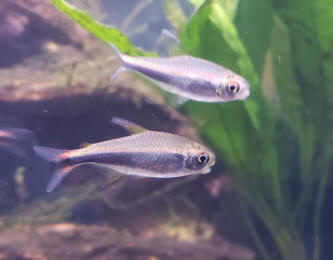
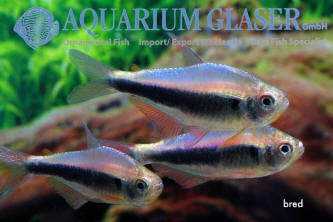 |
|
|
Tetra sudden illness 3/4/19
Howdy,
<Doody,>
We’ve a 29 gal tank we clean & test weekly. Normal ranges. 5 Serpae tetras, 3
other tetras (silver?) a loach and a Pleco. been with us 2+ years with no
problems. Everyone ELSE is fine.
<Cool.>
Between yesterday morning roll call and today’s, this Serpae tetra went ghost
pale, floating weird a la swim bladder, and I think he/she looks bloated. Wedged
itself into plant leaves. And stopped moving & swimming. Infrequent breathing.
Any ideas on illness?
<Hard to say. Small tetras sometimes contract diseases that are all very similar
in appearance (lethargy, loss of colour, disinterest in food, perhaps social
behaviour oddities like leaving the group and hiding instead). In some cases
they are bacterial, in others microbes of other types, like Pleistophora. In all
honesty, with these very small fishes, it's often best to simply euthanise to
reduce the risk of cross-infection. Clove Oil does the job nicely.
http://www.wetwebmedia.com/euthanasia.htm
Serpae Tetras are generally very tough, legendarily so, though they are also
notoriously nippy towards other fish and aggressive towards their own kind,
especially when feeding. There are some lookalike species (such as Ember Tetras)
that aren't nearly so tough, and don't handle hard water (for example) as long
as Serpae Tetras. So I'd keep an open mind in that direction, too. Cheers,
Neale.>
|
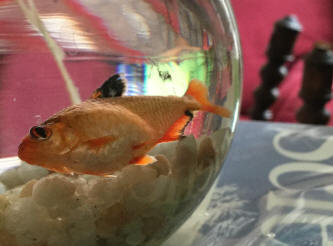 |
|
Hello! /Neale 11/2/18
First I would like to say that this website has been a complete
obsession almost for any little thing that I ever seem to have questions
about. I haven't had to actually write more than once before now. You
all are lifesavers! Literally. With this particular situation though I
am completely stumped. I have gone through everything I can on here and
have not found a match yet that I can see. I will start with a bit of
history, not too much though and water parameters. This is a 30gal long,
planted tank. Everything from stem plants to floating hornwort. Home to
a shoal of 6 albino Cory's ranging from 1-3 1/2 years of age. A school
of 6 Glofish (skirt) tetras also ranging the same age. A small school of
6 Glolight tetras. A pair of juvenile peacock gudgeons and a male Betta
that is a little over 2 years old. Water parameters are in ppm... 0 amm,
0 nitrite, less than 10 nitrate, GH around 80ppm, KH around 50-60ppm and
PH ranges between 7-7.2. I do use peat moss and air stones in my 20gal
water tank that I keep cycled and full for water changes as my water
here comes out a hard 280-300 GH, about 120-150 KH and a PH of 8.4-8.6.
I top off with a mixture of distilled and spring water. My question is
about one of my older tetras. She has developed 2 odd pimple-like spots
on her but they have come up from under her scales and pushed them out.
Its hard to get a good pic of as her scales reflect back the light and
the 2 "whitehead" looking bumps are under. She is about 3 1/2years old
and roughly the size of a 50¢ piece. She acts completely normal and is
eating normally and such. I first noticed these 2 bumps about a week ago
and they don't seem to have gotten bigger or gone down any. I thought
maybe some kind of parasite but nothing I have read about sounds like
this. The only new fish to the tank within the past year are the
gudgeons and they have been added in the past month. They have settled
in nicely and seem healthy. Idk if they could have brought something
with them or if its unrelated. I am attaching the best pic I could get
but getting her holding still enough for any length of time to take a
pic is not an easy task. Any thoughts or help/advice is greatly
appreciated! Thanks, Allie.
<<Bob's covered the basics, but will add an observation re: Hemigrammus
rodwayi, the Gold Tetra. This species is actually silver in colour, but
the ones in the trade are infected with a non-lethal trematode
parasite. I believe this happens naturally, in the wild, rather
than a manmade thing. Anyway, the parasite causes the skin to secrete
extra guanine, and that forms metallic gold patches, hence the common
name of the fish. Praziquantel and other antihelminthic medications have
been used successfully against trematodes, though in the case of the
Gold Tetra the fish itself appears to be unharmed so such treatment is
rarely, if ever, done by home aquarists. Still, it's an option. Of
course first of all I'd be treating as per Whitespot and Velvet, just in
case either of those (or some similar ciliate parasite) are to blame.
The old salt/heat method can work very well, and has minimal toxicity if
done correctly. Otherwise, if the tankmates aren't sensitive to standard
anti-Whitespot medications, you could try a couple runs of those (Velvet
in particular seems to need two courses to be thoroughly dispensed
with). Good luck, Neale.>>
Re: Hello! 11/2/18
OK, I don't have any salinity in the tank at all as the Cory's don't
seem to like it.
<Soft water fish, including Corydoras, are just fine at the 2g/litre
used to treat Whitespot. Just as a reminder, other medications often
include copper sulphate and formalin, which are FAR more toxic than
salt, particularly to catfish and loaches. Hence the old salt/heat
method remains a very useful approach for handling Whitespot and Velvet
in situations where other medications aren't an option. Do also note
than 2g/litre IS NOT brackish water, and furthermore, the salt/heat
method operates over a week or two. A lot of people get confused by the
salt dosage, and assume it'll turn the tank brackish. It really won't.>
I do have both the API Aquarium Salt ( just incase ) and Instant Ocean (
I have a low end brackish set up on another tank ).
<The API tonic salt is the one you want. While the Instant Ocean salt
would work, it'd also raise pH and hardness. Plain non-iodised cooking
salt, or some aquarium specific alternative, only affects salinity, and
has no impact at all on pH and hardness.>
I can treat with if necessary. The temp stays between 76-78°.
<Traditionally the temperature is knocked up a few degrees to speed up
the life cycle of the Whitespot or Velvet parasite. Once mature, the
motile stages burst out of the fish, allowing them to swim about looking
for a new host, but crucially, this is THE ONLY stage at which they can
be killed. They have little tolerance for salt, much less than fish, so
the salt added to the water kills them. Anyway, 28-30 C/82-86 F is
considered optimal for the heat/salt technique. Since warm water has
less oxygen than cold, you need to up the aeration during the process,
or the fish may become stressed.>
I have looked into the velvet and it doesn't seem like that but it could
be I reckon and I'm pretty sure its not the Whitespot/ick.
<Velvet tends to be like powdered sugar, often resulting in a golden
sheen. Attacks the gills first, so affected fish often gasp, breathe
heavily, or look nervous and distressed. Velvet usually progresses
extremely rapidly. Whitespot more like table salt, with visible pimples.
Often develops more slowly.>
I have had a bit of experience with that over the years but I will
definitely be watching close and will treat the tank if other fish start
developing whatever this is. I haven't moved her to the hospital tank
yet as I'm not sure if that would help or hinder the situation.
<Indeed.>
I think she would be really stressed by herself but I will do it if its
necessary. I did notice today that she has 2 identical spots on the
other side in the exact same places. Just not as noticeable. No other
spots anywhere else and they are right in a horizontal line almost like
its part of her spine or something. I thought the spine was higher up
though. I don't have much in the way of meds on hand aside from Melafix.
<Melafix largely useless.>
The ones I had expired unused months ago and I just haven't replaced
them yet but I will. I really appreciate you guys taking the time to
respond! If you think of anything else please let me know. Thanks again.
<Cheers, Neale.>
Re: Hello! 11/2/18
I can't believe I didn't attach those pics! I was really sleepy when I emailed
lol. Sending now and looking into Microsporidian and see what I can find! Thank
you.
<Oh! Another possibility is that these spots are resultant from
reproductive, hormonal cause... "Nuptial tubercles"... These too shall pass if
so. BobF>
|
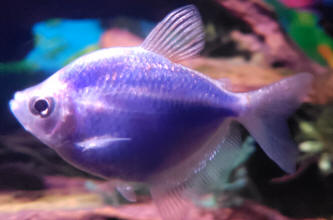 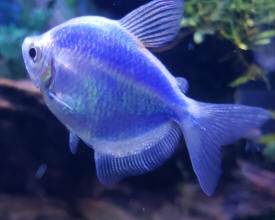 |
|
Re: Hello! 11/2/18
Wow! Never heard of that! I will look into that as well thank you! I'm just glad
that it will pass if so. I am rather attached to my fish and was really worried.
<I sense/d this; and am glad for it. These organisms are dependent on our care
entirely.>
Especially considering that they are genetically altered. This has been my first
time owning fish that have been altered in such a way.
<Aye; a bit of "jellyfish DNA" clipped on eh?>
They have been much healthier than I originally thought they would be with no
losses as of yet. Quite hardy and comical little guys. Thank you very much for
the insight!
<Glad to share. Bob Fenner>
|
|
Ember tetra pathogen 10/22/18
Dear Crew,
<Amber>
I am hoping you can help me to diagnose what I believe to be a disease slowly
killing off my ember tetras. I am wondering if it is Pleistophora, but all of
the symptoms don't quite seem to match up with that. Anyway, before I get into
it, here are the basics of the tank.
Planted 29g with Aqueon20 filter (with additional/better filtration media) and
sponge filtration, kept at 78-80 degrees F. Water parameters are good and I do
~30% water changes once per week (sometimes it goes 2 weeks). I use soft,
slightly acidic tap water that I treat with Seachem Prime. I have occasionally
dosed the tank with Flourish Excel but generally don't add anything to the water
except Prime for conditioning during water changes.
This tank has been set up for around 7 months.
The tank is currently stocked with:
9 ember tetras
3 Otocinclus
6 hockey stick Pencilfish
1 (Micro)Ctenopoma ansorgii
2 gold rams
1 large Amano shrimp
1 Nerite snail
I feed 1-2x per day. Most days they get a bit of Nutrafin Basix Staple Food and
Nutrafin Bug Bites Cichlid Formula. Around 1-2x per week I feed them Hikari
frozen brine shrimp and I also add about 1/2 of a Hikari algae wafer a few times
per week (though I don't think the embers get much of that).
Over the past 7 months they have gotten Hikari frozen blood worms maybe 6x and
freeze-dried blood worms maybe 20x (though they haven't gotten any blood worms
in the past probably 1-2 months).
<Good>
The first fish I added to the tank were a few embers. Since then, I have added a
few more, as well as the other listed occupants (more or less in the above
listed order). Over the course of the past 7 months, I have lost 3 ember tetras
but I have had no other illness or suspicious deaths in this tank (one ram got
wedged and died behind the intake sponge on my HOB). I blamed the first ember
death on stress or injury related to transfer between tanks. A few months later,
I found another ember dead in the tank.
Everyone else seemed healthy, so I convinced myself this was just another
'fluke' death (pardon the pun). I was hoping there was no disease problem in my
tank but these losses made me suspicious, so I have been keeping a close eye on
it. I lost the third ember about 2 weeks ago. It started when I noticed that the
stomach on one of my embers looked slightly misshapen, distended, and her organs
seemed darker in colour than the other embers. I wasn't sure if I was imagining
things. The next day, she looked worse. The bulge on her stomach was larger and
was sliiightly fuzzy and whitish at the apex. It looked to me like some sort of
internal problem was finally pushing its way through her skin. She was swimming
around normally - and I assume eating - with the other fish. I decided she was
going into quarantine. After chasing her around the tank for awhile, I finally
caught her in a net, BUT when I first caught her, she was pinned against the
glass a little bit. I was VERY gentle but apparently this pinning, or just the
act of scooping her into a net, was enough to rupture the bulge in her stomach.
I could not find whatever had ruptured out of her. I put her into a glass jar
and expected her to die pretty quickly - she had a gaping hole in her stomach
cavity. She continued to live for probably an hour or two before I euthanized
her. Thinking back on the previous deaths, I am convinced there is a pattern
here. All three had something funny going on with their stomachs. I don't
remember many details from the first 2 deaths
other than some fuzziness/tissue damage to the stomach area and dark areas
inside the stomach cavity. I have done some searching on WWM and what I am
experiencing sounds VERY similar to the posted email 'Mystery ember tetra
illness' from Lea on 8/25/12.
I am hoping you can help me figure out what is going on. I didn't get any
pictures with this ember's stomach intact, but I took some after she died (first
pic attached). I stored her in the fridge overnight and looked at her under a
microscope the next day. Since I lost the majority of the 'growth', I wasn't
sure what I would find, but I believe I have some images of whatever this
pathogen is. The scale bars didn't export properly with the images when I saved
them however, they are at 100x-200x magnification
and the images have not been cropped, just resized.
<Thank you for this useful info>
The first microscope image is wet-mounted without a cover slip. The focus is
poor but this pic lets you see how spherical the objects are, as well as the
black 'filaments' covering their surfaces. The second microscope image is of a
cluster of similar objects wet-mounted between slides. Prior to squishing them,
they were spherical and clustered together kind of like grapes. These ones did
not have the back material surrounding them as some others did. If you zoom in,
you can see how some of these spheres seem to be dividing. The third microscope
image is of the black speck that is visible toward the tail of the tetra in the
first image. It was hard to tell if this speck was embedded in the muscle tissue
or just pushed toward the far end of the gut cavity. I dissected it out of the
fish and wet mounted it. Prior to mounting, it seemed spherical and was
completely covered in the same back filaments as some of the other objects were.
It easily squished flat between slides, it was not hard or difficult to flatten.
I think this image might have been zoomed in a bit more than the others, but
this object was noticeably larger than the others. I have several more images if
you would like to see them. I just didn't want to bog down your server with all
of them at once. I scaled down the attached images as much as I could. Please
let me know if the resolution is too low.
<A more highly resolved image would be useful>
I would also like to note that my Ctenopoma likes to sneak up on the embers and
Pencilfish occasionally and bite their tails, but they seem to recover from
these bites very quickly. I am working on an alternate housing solution for my
Ctenopoma (I really don't want to give him away - he's such a character) I
realize that the tail nipping may be exacerbating the situation with the gut
pathogen but I don't think the two are directly related. Just wanted to share
this as a further detail.
<African Leaffish, Ctenopoma species, will eat/inhale small-enough fishes>
I am not sure how or with what I should treat this tank. I have posted to fish
lore and got some educated suggestions. I have also talked to Andrea at
Aquarium101 (my local fish store) and she recommended that I contact you for
advice. She said you have been amazing help with their Flowerhorn, Jiana, and
her swim bladder illness.
I am dying to know what this pathogen is and if there is anything I can do to
treat it. Also, if it is likely to spread to the other species in my tank. So
far suggestions have been Praziquantel and Metronidazole, both of which I have
but I have not treated the tank with either yet. I would very much appreciate
your expert feedback.
Thank you very much,
Amber
<Have some ideas... but am going to ask Neale Monks here to respond first. Bob
Fenner>
|
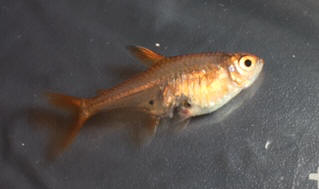
.jpg)
 |
|
Re: Ember tetra pathogen
10/23/18
Thank you for your response! Looking forward to hearing more. I have attached
higher resolution images this time. Hope that’s ok. Also wanted to point out
that the bush fish is a Microctenopoma ansorgii. I wasn’t sure if the proper
genus for this one was Microctenopoma or Ctenopoma.
<The former; and yes, I did see that it is this small species (to about 2") that
you have. Even little, they do have large mouths and as you noted, are given to
predatory behavior>
Sorry for any confusion on that point. First and second images are zoomed in, I
think to 200x, from two of the previous images. The others are just higher
resolution of previous images.
Amber
<Let's still wait on Neale's independent response. I am presently given to think
the round objects may be eggs, the damage, losses here due to trauma. BobF>
Ember tetra pathogen /Neale
10/23/18
Dear Crew,
<Amber,>
I am hoping you can help me to diagnose what I believe to be a disease slowly
killing off my ember tetras. I am wondering if it is Pleistophora, but all of
the symptoms don't quite seem to match up with that. Anyway, before I get into
it, here are the basics of the tank.
<It may be Pleistophora, but this is indistinguishable from bacterial infections
such as Flavobacterium infections. So to some degree you need to keep an open
mind, even where Neon Tetra Disease seems likely.>
Planted 29g with Aqueon20 filter (with additional/better filtration media) and
sponge filtration, kept at 78-80 degrees F. Water parameters are good and I do
~30% water changes once per week (sometimes it goes 2 weeks). I use soft,
slightly acidic tap water that I treat with Seachem Prime. I have occasionally
dosed the tank with Flourish Excel but generally don't add anything to the water
except Prime for conditioning during water changes.
This tank has been set up for around 7 months.
The tank is currently stocked with:
9 ember tetras
3 Otocinclus
6 hockystick Pencilfish
1 (Micro)Ctenopoma ansorgii
<Nice fish!>
2 gold rams
1 large Amano shrimp
1 Nerite snail
I feed 1-2x per day. Most days they get a bit of Nutrafin Basix Staple Food and
Nutrafin Bug Bites Cichlid Formula. Around 1-2x per week I feed them Hikari
frozen brine shrimp and I also add about 1/2 of a Hikari algae wafer a few times
per week (though I don't think the embers get much of that).
Over the past 7 months they have gotten Hikari frozen blood worms maybe 6x and
freeze-dried blood worms maybe 20x (though they haven't gotten any blood worms
in the past probably 1-2 months).
<All sounds fine.>
The first fish I added to the tank were a few embers. Since then, I have added a
few more, as well as the other listed occupants (more or less in the above
listed order). Over the course of the past 7 months, I have lost 3 ember tetras
but I have had no other illness or suspicious deaths in this tank (one ram got
wedged and died behind the intake sponge on my HOB). I blamed the first ember
death on stress or injury related to transfer between tanks. A few months later,
I found another ember dead in the tank.
Everyone else seemed healthy, so I convinced myself this was just another
'fluke' death (pardon the pun). I was hoping there was no disease problem in my
tank but these losses made me suspicious, so I have been keeping a close eye on
it. I lost the third ember about 2 weeks ago.
<At this point I'd just give up with Ember Tetras for the time being. It might
be that something about the tank, the water, or your maintenance regime isn't
appropriate to the species. It might also be a 'bad batch' of them, and if you
wait six months, or find another retailer, you might do better.>
It started when I noticed that the stomach on one of my embers looked slightly
misshapen, distended, and her organs seemed darker in colour than the other
embers. I wasn't sure if I was imagining things. The next day, she looked worse.
The bulge on her stomach was larger and was sliiightly fuzzy and whitish at the
apex. It looked to me like some sort of internal problem was finally pushing its
way through her skin. She was swimming around normally - and I assume eating -
with the other fish. I decided she was going into quarantine. After chasing her
around the tank for awhile, I finally caught her in a net, BUT when I first
caught her, she was pinned against the glass a little bit. I was VERY gentle but
apparently this pinning, or just the act of scooping her into a net, was enough
to rupture the bulge in her stomach. I could not find whatever had ruptured out
of her. I put her into a glass jar and expected her to die pretty quickly - she
had a gaping hole in her stomach cavity. She continued to live for probably an
hour or two before I euthanized her. Thinking back on the previous deaths, I am
convinced there is a pattern here. All three had something funny going on with
their stomachs. I don't remember many details
from the first 2 deaths other than some fuzziness/tissue damage to the stomach
area and dark areas inside the stomach cavity. I have done some searching on WWM
and what I am experiencing sounds VERY similar to the posted email 'Mystery
ember tetra illness' from Lea on 8/25/12.
<You might try deworming, using something like Prazi Pro.>
I am hoping you can help me figure out what is going on. I didn't get any
pictures with this ember's stomach intact, but I took some after she died (first
pic attached). I stored her in the fridge overnight and looked at her under a
microscope the next day. Since I lost the majority of the 'growth', I wasn't
sure what I would find, but I believe I have some images of whatever this
pathogen is. The scale bars didn't export properly with the images when I saved
them however, they are at 100x-200x magnification and the images have not been
cropped, just resized.
<Nice pictures!>
The first microscope image is wet-mounted without a cover slip. The focus is
poor but this pic lets you see how spherical the objects are, as well as the
black 'filaments' covering their surfaces. The second microscope image is of a
cluster of similar objects wet-mounted between slides. Prior to squishing them,
they were spherical and clustered together kind of like grapes. These ones did
not have the back material surrounding them as some others did. If you zoom in,
you can see how some of these spheres seem to be dividing.
<Does sound like some sort of protozoan parasite. If that's the case, something
along the lines of Metronidazole would be the better bet.
Together with an antibiotic such as a Nitrofuran, this combo tends to cover a
wide range of non-worm parasites.>
The third microscope image is of the black speck that is visible toward the tail
of the tetra in the first image. It was hard to tell if this speck was embedded
in the muscle tissue or just pushed toward the far end of the gut cavity. I
dissected it out of the fish and wet mounted it. Prior to mounting, it seemed
spherical and was completely covered in the same back filaments as some of the
other objects were. It easily squished flat between slides, it was not hard or
difficult to flatten. I think this image might have been zoomed in a bit more
than the others, but this object was noticeably larger than the others. I have
several more images if you would like to see them. I just didn't want to bog
down your server with all of
them at once. I scaled down the attached images as much as I could. Please let
me know if the resolution is too low.
<They're fine.>
I would also like to note that my Ctenopoma likes to sneak up on the embers and
Pencilfish occasionally and bite their tails, but they seem to recover from
these bites very quickly. I am working on an alternate housing solution for my
Ctenopoma (I really don't want to give him away - he's such a character) I
realize that the tail nipping may be exacerbating the situation with the gut
pathogen but I don't think the two are directly related. Just wanted to share
this as a further detail.
<Microctenopoma ansorgii is a lovely fish, and has a fair sized appetite, so
maybe offer a little more food? Should be fine with robust tetras, though Embers
are probably a bit small.>
I am not sure how or with what I should treat this tank. I have posted to fish
lore and got some educated suggestions. I have also talked to Andrea at
Aquarium101 (my local fish store) and she recommended that I contact you for
advice. She said you have been amazing help with their Flowerhorn, Jiana, and
her swim bladder illness. I am dying to know what this pathogen is and if there
is anything I can do to treat it. Also, if it is likely to spread to the other
species in my tank. So far suggestions have been
Praziquantel and Metronidazole, both of which I have but I have not treated the
tank with either yet. I would very much appreciate your expert feedback.
<Either or even both worth a shot. Metronidazole would be my first choice
though.>
Thank you very much,
Amber
<Cheers, Neale.>
|
|
Rosy tetra with hole in the belly
8/24/18
Hi,
I was wondering if you could help me.
<Sure thing.>
I have a 25 liters fish tank in which I've been housing 2 females lf rosy tetra
for the last 3 years.
<These are nice, usually unproblematic tetras.>
Fish keeping is not my priority but I've been regularly changing 25-50% of the
water and tried to keep the tank relatively comfortable for these 2 fish to
live.
<Understood. However, 25 litres is much, much too small for these fish.
It's barely adequate even for a single Betta. It would also explain your
problem.>
A couple of months ago one of them developed a black round dot on it's belly
around the anal area.
<Yes; possibly a wound, but hard to say at this point.>
That dot has slowly grown larger and yesterday I noticed it looked like she had
cotton on the dot. Well today the "cotton"-like fluff disappeared but she has a
massive dent/hole on her belly.
<I can see this, yes. The white stuff coming out from the wound is dead tissue,
likely muscle and skin tissue. It's what we'd call an infected ulcer in the case
of a human, and while the cause is hard to pin down, it's evidently infected
with bacteria that are causing the wound to explain (and preventing it from
healing).>
She acts normal and eats normal however the wound doesn't look all right at all.
<I'll say!>
I was wondering if you would happen to know what this is and if there is a way
for me to help her at all?
<Two steps. Firstly, a bigger world with better water quality. With the best of
intentions, as I'm sure you have just reading this message, 25 litres is, what,
6 or 7 US gallons? For this species you'd really need at
least 2-3 times that amount of water to be considering this a "healthy"
environment. Too little water means too many bacteria, and too little water also
means too little dilution of metabolic wastes. Regular water changes help, for
sure, but realistically you'd need to be changing the water every day or two
simply to create conditions similar to, say, a 60-75 litre/15-20 US gallon tank
that received water changes every week or two. There's just no sense to that
amount of work, especially if fishkeeping is a casual
hobby. Put another way, the less work you want to do, the bigger your tank needs
to be. The smaller the tank, the harder work it'll be, and ultimately more
expensive once you factor in dead/replacement fish and medications.
Now, the second thing to do is treat as per Finrot. Again, let me stress here
that medications are like sticking plasters -- they're fine once the injury is
done, but if the patient keeps sticking knives in themselves, plasters aren't
going to help! Similarly, if the water conditions don't improve, you'll be
repeating the medication again and again because the bacteria will keep coming
back. Aeromonas and Pseudomonas spores are everywhere, and you really can't keep
them out of the tank any more than
you can live your own life germ-free. Can I also add that medications vary in
quality. The tea-tree oil ones are generally cheap but unreliable, so avoid.
Salt is equally worthless, though often recommended to inexperienced hobbyists.
Instead look at a proper antibiotic (if available in your country from a pet
store) such as Maracyn 2 or Kanaplex, or else a trusted antibacterial like eSHa
2000 or Waterlife Myxazin.>
Please see some photos attached
Kind regards, Anda
<Hope that this helps. Cheers, Neale.>
|
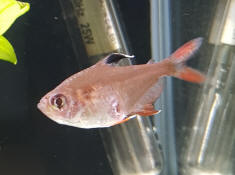
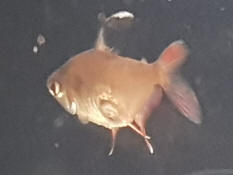
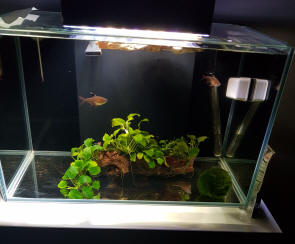 |
|
Columbian tetra with fin rot from nipping
5/20/18
Hi Neale and Bob,
<Susan,>
You helped me save a zebra Danio who was badly injured from a bullying
situation. He has healed beautifully and your suggestions on rearranging the
tank and reintroducing the Danios solved the bullying problem.
<Well, that's a good outcome!>
One of my Columbian tetras appears to be the victim of fin nipping with
accompanying fin rot now setting in. There are two spots visible (see photo).
This school usually gets along great although they do chase one another on
occasion.
<This species is prone to that. Bigger groups usually help fix the problem. In
any event, medicate as per Finrot.>
I do weekly water changes of 20%. Water parameters are as follows: Zero for
ammonia and nitrite. Nitrates around 20 ppm, gH at 7-8°, temp around 76°F, pH
6.8. I run a canister filter with biomedia that includes matrix and chemical
filtration is Chemipure green. I also run a sponge filter rated for 20 gallons
which is connected to a battery backup air pump (we have frequent power outages
where I live).
<Oh!>
Other tank inhabitants are a school of orange laser Corydoras and MTS (substrate
is sand) and Nerite snails. Tank is a 20 gallon planted. I have upped my water
changes to 10% every 3 days since I discovered the fin rot. It does not appear
to be getting worse and the tetra is active and eating but I don't want it to
progress further. I can't use aquarium salt because of the Corys.
<Who told you that? Low salt doses, i.e., 2 g per litre, for treating Whitespot
for example, will do them less harm/cause less stress than traditional
medications using copper or formalin. To be clear, catfish aren't "allergic" to
salt. That's a myth. A lot of salt in the water will cause osmoregulatory
stress, but trivial salt doses are perfectly safe, even with soft water
specialists like Cardinals, let alone Corydoras.>
I do have SeaChem Paraguard on hand that I used to treat my Betta who had fin
rot when I purchased him. Do you think its advisable to treat the tetra in the
tank with Paraguard?
<I would.>
I can relocate the Nerites and the larger MTS who are active at night and
visible on the substrate. MTS are expensive here and only available online so I
would prefer not to kill them off.
<Understood. While Melanoides snails usually handle medications just fine, you
could dump a few in a loosely covered food container with a bit of water and
leave them out of the tank while medicating. They need little care and will go
dormant when cool. The Nerites perhaps a bit more a gamble, being more sensitive
generally.>
I can also transfer the tetra to a small hospital tank.
<Perhaps put the snails here?>
I had ordered Kanaplex with the intention of adding it to food with their binder
Focus, but I was sent the wrong product so it will be about 5 days until the
Kanaplex arrives. The Kanaplex was my backup plan if the water changes didn't
help. What is the safest course of action in your expert opinion?
<Any medication for Finrot should be fine here. This fish looks in robust
health, and really all you want to do is help knock back the bacteria a bit so
it's own immune system can kick in.>
Thanks for your help (again).
Susan
P.S.
I'm moving everyone to a 50 gallon planted tank that has just finished cycling
once it was settled in and aged a bit. Hopefully that will solve the territorial
problems.
<Understood. Cheers, Neale.>
|
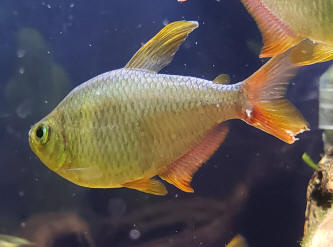 |
|
Re: Columbian tetra with fin rot from nipping
5/20/18
Thanks Neale!
I am happy to learn that corys can tolerate salt if I ever have to use it in my
tank.
<To be clear, as a short-term treatment for Whitespot and Velvet at low doses (2
g/l, for a few days or a couple of weeks). Perfectly safe used that way. But I
would not be adding salt as a regular addition to any community tank containing
relatively soft water fish, whether Corydoras, tetras or anything else from the
Amazon Region.>
Another myth busted.
<It would seem so!>
I went ahead and removed my snails and I'm treating with Paraguard. I will
definitely follow your advice and increase my school of tetras once I've
relocated them to the 50 gallon.
<Cool.>
Thanks again for your help.
Susan
<Most welcome. Neale.>
|
|
Congo tetra swollen. 3/30/18
Hello crew. Hope you are doing alright.
Today one of my Congo tetras, the biggest and dominant male appeared with a big
swollen and open mouth. His head looks very red and swollen. He is still
responding to stimulus but very weakly. His condition is worsening by the hour,
so this is a very aggressive ailment. He was not like this yesterday. Other
notable symptoms are an under jaw with marked veins, a small blood blotch near
the pectoral fins.
This looks horrible and I've never seen anything like this. He does fight a lot
with a certain other male to the point of pursuing each other across the whole
150 gallon aquarium they are in.
I've had my group of Congos for two years now. When i first got them they came
with a type of mouth fungus, something that looked like they are white gums and
no teeth (its the closest i can to describe it). It never got bad and it went
away once happy in my tank. Now all of a sudden this. I checked the other Congos
and there is one with the same white gum thing that i saw two years ago, but it
is not hindering in normal feeding or behavior. I conducted a large water change
(50%).
I have quarantined the sick fish into a 5 gal bucket with 1/2 Methylene blue and
will be waiting on response. Its 8 pm and i don't think i can go get anything
difficult right now and i don't think he will make the night if i don't do
something right now.
I have malachite green, Metronidazole, and Levamisole in my med box. Any
opinions crew?
<This does look like the infamous 'Mouth Fungus' to me, which despite its name,
is a bacterial infection nowadays more often called Columnaris after the
bacterium species responsible, Flavobacterium columnare. It can be extremely
aggressive, and while it can be treatable, you need to work promptly. A strong,
reliable antibiotic is necessary -- Kanaplex of example is known to be
reasonably effective. Outside the US, access to antibiotics can be limited, but
I have found eSHa 2000 to be quite effective as well, especially if the problem
is caught early on (it's less effective once the fish is really weak). Neither
Methylene Blue, Malachite green, Metronidazole, or Levamisole are useful here.
Do bear in mind Columnaris is opportunistic and to some degree caused by things
like fighting and less than perfect water quality, so reviewing the tank is
important as well. Cheers, Neale.>
|
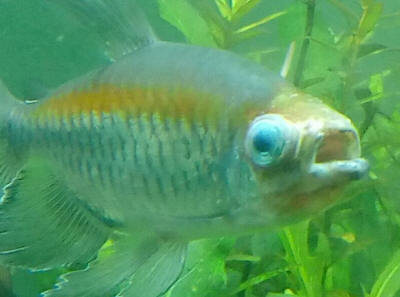 |
|
Help with neon tetra 6/15/17
<12 megs; groan....>
Dear Crew at Wet Web Media,
Tank - 100 liter
Ammonia 0, Nitrite 0, Nitrate 15, GH 10, KH 7, PH 7.5
8 cherry barb, 8 emperor tetra, 7 neon tetra, 2 phantom tetra
Fluval external canister filter, internal air driven sponge filter.
I have previously kept a 50 liter tank and decided to move to a 100 liter about
6 months ago. I quarantined all fish for 6 weeks and tank was cycled from the
start as I used media from old tank.
After about a month in the main tank, one of the Neons developed a white
lump on both sides of the tail on the red part. These grew very slowly
for about a month and another smaller lump developed on its side, closer to the
middle of its body. Once or twice one of the lumps seemed to exude a white
substance which then went after a day or two but the lump remained. Otherwise
the fish swam, ate and behaved normally. Eventually, the lumps got wider and the
fish started to have trouble breathing but was still trying to eat etc. I
decided to euthanise with clove oil. This was a week ago. Just today, I noticed
another neon has developed a small but telltale white lump in the same red
pigmented area. I don't know what to do as I have no idea what it is. Fungus,
Columnaris, neon tetra disease,
<This likely: Pleistophora hyphessobryconis>
I've looked them all up but none of them really fit. Because of this I did not
medicate as it seemed like I was firing in the dark. If you have any advice or
just a hunch as to what it could be I would really appreciate it.
The worst thing is that it doesn't really fit any one disease That are common to
neon tetra.
<See here as an example:
http://www.theaquariumguide.com/articles/neon-tetra-disease
Bob Fenner>
|
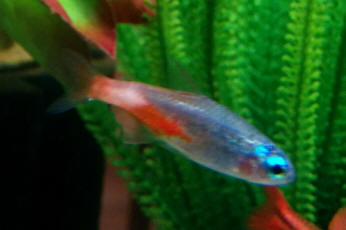 |
|
Re: Help with neon tetra 6/16/17
Hello,
<Vic>
Thank you for your quick reply.
<Welcome>
Could I just ask you, if it is Neon Tetra Disease, can it infect my other
fish, being cherry barb, emperor and phantom tetra?
<Unfortunately, yes. More likely the other Tetras, but the Barbs as well>
Also, I assumed it was a very fast acting disease, killing the fish quickly,
so in my case can the disease be chronic, and take over a month to kill the
fish?
<At times; yes>
Many thanks,
Vicki
<As many welcomes. BobF>
|
|
Ember Tetra black spots 12/29/16
Dear WWM,
Season's Greetings and best wishes for a happy 2017. Thanks for the awesome
job you keep doing.
<And thanks for the kind words.>
The attached image is of a few of my Ember Tetras of a group of 11 that have
been living happily for about 1.5 years in a heavily planted 29 gallon. Tank
is it its 6th year. Quick question: any idea what those black spots/marks
along the lateral line of the biggest fish signify? Or are they more likely
to be deposits internally along the spine? I do not have a
microscope so cannot sample a tissue scrape.
<They have the speckled, regular appearance of melanophores rather than
sharp black spots or cysts. So my assumption here is that they're part of
the fish rather than a parasite. Why is more difficult to answer! Sometimes
melanophores change colour for normal, such as sexual, reasons. Sometimes
fish turn the melanophores up or down because of ambient conditions such as
lighting (Moonlight Gouramis famously have a black band that appears only
under dim lighting). Sometimes they get 'jammed' in an unusual state by
damage to the nerves. Sometimes they're simply different because of
genetics, whether a mutation in this particular Ember tetra or because this
isn't actually a typical Ember tetra but an example of a related species or
hybrid. Bottom line, if the fish is behaving normally, I wouldn't worry.>
Tank has other tetras, Corys, a pair of Agassiz's, a Pearl Gourami and a
pair of Bristle Nose Pleco
High nitrates >40 ppm, pH 6.5, TDS 180 ish, 30 percent water change weekly.
Fed Hikari Micro Pellets, Tetra pellets, Ocean Nutrition Spirulina and brine
shrimp flakes, NLS Thera A and occasionally freeze dried blood and Tubifex
worms.
Tank has had episodes of what was diagnosed as NTD in Neons and Black Neons
and affected fishes euthanized as per your suggestion.
<Probably wise.>
Should mention that I add 4 ml 2 percent Glutaraldehyde daily to augment
CO2.
Any input will be most be most helpful.
Have a great year-end and thanks again,
Regards
Devakalpa
<And to you, too. Cheers, Neale.>
|
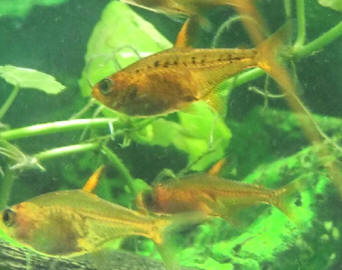 |
|
Re: Ember Tetra black spots 12/30/16
Dear Neale,
Thanks for the super fast and clarifying reply. I'll let things be, but keep a
watchful eye - my favourite approach to the hobby.
Regards
Devakalpa
<Glad to have helped! Good luck, Neale.>
|
|
Dark patches in X Ray Tetra 10/6/16
Dear WWM,
<Hey Dev>
Hope you all are doing fine. Thank you for the excellent site. My tank is in
its 6th year and it owes a lot to your site and things I learnt (and still
learning) from it.
<Ahh; deeply satisfying to realize we have helped>
Question: The attached images are of one of my 8 X Ray Tetras
(*Pristella maxillaris*). They have been in this 29 gallon for a
little over 2 years.
It is schooling, active, eating but I am worried about the dark patches.
Are they signs of NTD?
<Mmm; perhaps something else... but not good. This looks to me (signs wise)
like some sort of Sporozoan.... as far as I'm aware, still not treat-able...
You can/could sacrifice the animal, cut it up (sectioning, embedding and
staining as in histological study would be even better) and look under a
medium power 'scope.... but.... I would NOW remove and destroy (see Neale's
coverage re euthanasia on WWM) this specimen. There IS a chance of whatever
the problem here spreading to your other fishes>
Still no classical pale discoloration or deformation but one of my
Black Neons showed similar patches in the past and on your suggestion (and
my decision) I euthanized it.
Tank mates are other tetras, Cory cats, pair of Bristle Nose Plecos, a
Whiptail L010, a Pearl Gourami. No fish added in months, nor diseases or
deaths. Tank is heavily planted. Filtered by three 500 lph HOB filters
packed with sponge, bioballs, ceramic rings and Seachem Denitrate. No
Ammonia and Nitrite. NO3 40, 35% weekly water change, pH 6.9, TDS about 200
ppm, temp avg 27C. Fed Ocean Nutrition, Hikari and Tetra flakes and pellets,
occasionally freeze dried Blood, Tubifex worms and parboiled kitchen veggie
cuts.
Request you for some guidance on the possible course/s of action.
Isolating is bit difficult as my other tank has a leak and I would need to
keep in plastic tub.
Thanks again. You people are too good.
Devakalpa
<Am going to share w/ Neale here for his separate input. Bob Fenner>
--
*quis custodiet ipsos custodes?*
<Who indeed>
Re: Dark patches in X Ray Tetra /Back to Bob
10/7/16
Dear Bob,
<Yes Dev>
Thank you for the clarifying reply. I shall await Neale's input as well.
Two more questions if you don't mind:
Is this fish a threat to others even when alive?
<Mmm; much less so. It's thought that micro-Sporidean/sporozoans pass through
the consumption of flesh of an infested specimen... >
I mean can the infection spread to others or is it usually passed on when other
fishes consume the remains of an infected fish?
<Ahh; the latter>
If it can be helped I would like to delay the euthanizing till the fish is more
affected, as it is a depressing thought and it is so difficult to catch one in a
heavily planted tank. I shall employ the 2 net method.
<You're spot on here>
Secondly how did the protozoa, assuming it is so, get into the system?
<Through another fish likely>
No other fish is seemingly affected, I have not introduced any fishes, esp.
Characids in months (only a pair of Apistogramma agassizii few months back)
and do not feed live foods. Can plants or snails carry them?
<I don't think so; but the imported fishes... do act as long/er term carriers
for sure>
Or can it lay latent as I had to 'put out' a Black Neon with suspected NTD more
than a year ago?
<I do think you're correct here>
I am just trying to understand the issue better.
<A pleasure to communicate w/ a sharp, curious mind>
Have a great day.
Regards
Devakalpa
<And you, BobF>
Dark patches in X Ray Tetra /Neale
10/7/16
Dear WWM,
Hope you all are doing fine. Thank you for the excellent site. My tank
is in its 6th year and it owes a lot to your site and things I learnt
(and still learning) from it.
<Thanks for the kind words.>
Question: The attached images are of one of my 8 X Ray Tetras
(*Pristella maxillaris*). They have been in this 29 gallon for a little
over 2 years.
It is schooling, active, eating but I am worried about the dark patches.
Are they signs of NTD?
<Possibly; but there's some discussion that many examples of Neon Tetra
Disease are actually "False" Neon Tetra Disease, a catch-all name for
bacterial infections of various kinds. Sometimes sick Neon Tetras
recover when treated with antibiotics, which supports the idea that
some, though not all, examples of Neon Tetra Disease are bacterial
rather than caused by the protozoan parasite Pleistophora. I've written
about NTD for Fish Channel, and rather than going through it all again
there, let me direct you to this article:
http://www.fishchannel.com/fish-health/freshwater-conditions/neon-tetra-disease.aspx
Most aquarium healthcare books cover it too, and yes, the prognosis is
usually poor.>
Still no classical pale discoloration or deformation but one of my Black
Neons showed similar patches in the past and on your suggestion (and my
decision) I euthanized it.
<Agreed; doesn't look like classic NTD, but certainly a sick fish of
some sort. Worth treating with a general purpose antibiotic or
antibacterial, for example Kanaplex, to see if that helps. Costia is
another disease worth considering. It is fairly common, and typical
symptoms include stress colouration (often oddly dark or pale compared
to normal) and patches of white or grey (excess mucous) on the body.
Also known as Ichthyobodo and Slime Disease.
http://www.fishchannel.com/fish-health/freshwater-conditions/slime-disease.aspx
Difficult to treat, but I've had fairly reliable success over the years
using eSHa 2000. Other products targeting Costia, such as Sera Costapur,
are out there too.>
Tank mates are other tetras, Cory cats, pair of Bristle Nose Plecos, a
Whiptail L010, a Pearl Gourami. No fish added in months, nor diseases or
deaths. Tank is heavily planted. Filtered by three 500 lph HOB filters
packed with sponge, bioballs, ceramic rings and Seachem Denitrate. No
Ammonia and Nitrite. NO3 40, 35% weekly water change, pH 6.9, TDS about
200 ppm, temp avg 27C. Fed Ocean Nutrition, Hikari and Tetra flakes and
pellets, occasionally freeze dried Blood, Tubifex worms and parboiled
kitchen veggie cuts.
<All sounds fine.>
Request you for some guidance on the possible course/s of action.
Isolating is bit difficult as my other tank has a leak and I would need
to keep in plastic tub.
Thanks again. You people are too good.
Devakalpa
<Most welcome, Neale.>
Re: Dark patches in X Ray Tetra /Back to
Neale 10/8/16
Dear Neale,
Thank you so much for the detailed response.
<Most welcome, Devakalpa.>
After inputs from experts like Bob and you I have a much clearer idea of the
road ahead. I plan to observe for a couple of more days and keep offering
optimized conditions as the fish is otherwise very normal in sense of activity,
shoaling and feeding. Then with indications of worsening if any, shall isolate,
treat with Kanaplex and hope for the best.
<Sounds good; personally, I might actually treat the whole tank. If it is Neon
Tetra Disease, you may as well prevent cross-infection. I've not used Kanaplex
myself (it isn't sold in the UK) but Seachem state it won't affect the filter
bacteria, and being an antibiotic, it shouldn't irritate or harm sensitive fish.
Isolating characins for treatment is always a bit risky because they don't like
being alone, but if you do have a small, mature tank, then X-Ray Tetras are
pretty tough little fish, and for a few days a singleton should be fine. So
treating the tank or just the one fish should be okay!>
By the way though the links didn't work in Google Chrome, I could navigate to
the said pages at the Fish Channel site and read them.
<I wonder if the e-mail "snapped" the links in two, so they were on two separate
lines. Indeed, the links were merely typed in as URLs, not active links.>
Lucid, informative and helpful articles as always.
<Ah, glad to know you enjoyed them.>
Regards
Devakalpa
<Cheers, Neale.>
|
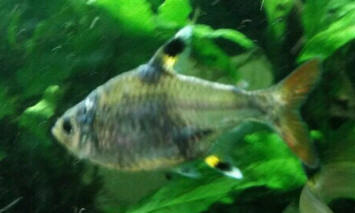
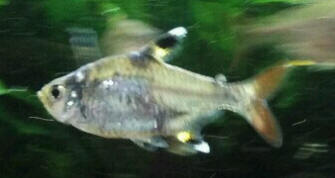 |
|
|

